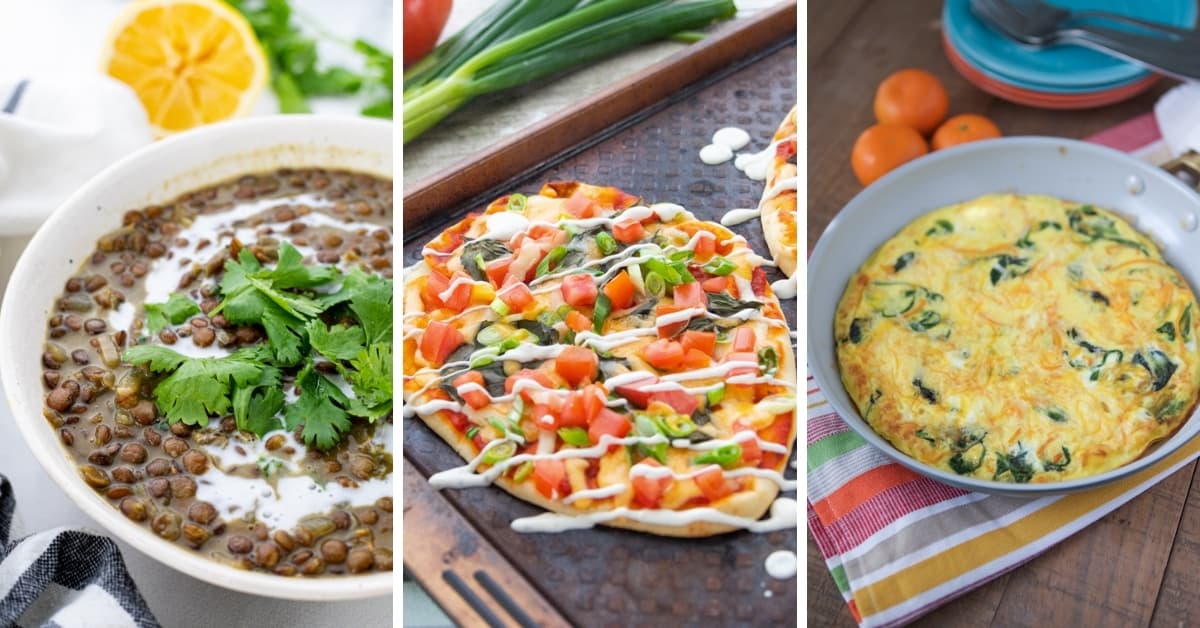Embark on a culinary journey that’s both delicious and budget-friendly! This guide unveils the secrets to crafting satisfying soy-free meals without breaking the bank. Discover clever meal planning strategies, master the art of utilizing pantry staples, and explore simple, yet flavorful recipes that will tantalize your taste buds. Learn to navigate grocery stores like a pro, maximizing your savings while minimizing food waste. Prepare to transform your kitchen into a haven of affordable, soy-free culinary delights.
From crafting weekly and monthly meal plans that incorporate seasonal produce to mastering the art of making your own soy-free broth, this comprehensive guide provides a wealth of practical tips and tricks. We’ll explore cost-effective protein sources, delve into simple, weeknight-friendly recipes, and share smart shopping and storage techniques to ensure your ingredients remain fresh and flavorful. Prepare for a vibrant exploration of textures, colors, and aromas as you create delicious and affordable soy-free masterpieces.
Mastering Soy-Free Pantry Staples
Building a well-stocked, soy-free pantry is the cornerstone of economical and delicious home cooking. By focusing on versatile, long-lasting ingredients, you can significantly reduce food waste and the frequency of grocery shopping, saving both time and money. This section will highlight key staples and demonstrate their use in budget-friendly recipes.
Essential Soy-Free Pantry Staples
Five essential ingredients form the backbone of a versatile soy-free pantry: canned beans (chickpeas, black beans, kidney beans), canned tomatoes (whole peeled or crushed), dried lentils (red or green), quinoa, and olive oil. These ingredients are relatively inexpensive, have long shelf lives, and can be incorporated into a wide array of dishes. For example, chickpeas can be roasted for a snack, blended into hummus, or added to salads and stews. Canned tomatoes are essential for sauces, soups, and stews, while lentils provide protein and fiber in soups, salads, and as a side dish. Quinoa offers a complete protein and is a versatile grain for bowls, salads, and as a substitute for rice. Olive oil serves as a healthy cooking fat and adds flavor to many dishes.
Budget-Friendly Recipes Using Canned Goods and Dry Ingredients
Minimizing food waste is paramount for budget-conscious cooking. The following recipes utilize canned and dry ingredients efficiently, maximizing their potential and minimizing waste.
- Lentil Soup: This hearty soup combines red lentils, canned diced tomatoes, carrots (if available), vegetable broth (homemade or store-bought), and your favorite herbs and spices. The lentils cook quickly, and the canned tomatoes add depth of flavor. Leftovers can be easily frozen for future meals, further reducing waste. Imagine a vibrant red soup, thick with lentils and fragrant with herbs like bay leaf and thyme. The tomatoes contribute a rich, deep red hue, and small flecks of carrot add a touch of orange.
- Chickpea Curry: This flavorful curry uses canned chickpeas, canned coconut milk, onions (if available), garlic (if available), ginger (if available), and a blend of curry powder, turmeric, and cumin. Serve with brown rice (or quinoa) for a complete and satisfying meal. The curry’s color is a rich golden-orange, flecked with the dark brown of the spices. The chickpeas are plump and soft, and the coconut milk creates a creamy texture.
- Quinoa Salad with Black Beans and Roasted Vegetables: This salad combines cooked quinoa with canned black beans, roasted vegetables (such as sweet potatoes, bell peppers, or zucchini), and a simple vinaigrette made with olive oil, lemon juice, and herbs. The vibrant colors of the roasted vegetables contrast beautifully with the earthy tones of the quinoa and black beans. The salad’s texture is a delightful mix of chewy quinoa, soft beans, and tender roasted vegetables.
Making Soy-Free Broth from Scratch
Homemade broth offers a significant cost advantage over store-bought options, while allowing for complete control over ingredients and flavor. It also minimizes packaging waste.
- Gather Ingredients: Collect vegetable scraps (onion peels, carrot tops, celery ends), herbs (bay leaf, thyme, parsley), and water. Avoid using cruciferous vegetables like broccoli or cabbage as they can impart a bitter taste.
- Prepare the Stockpot: Place the vegetable scraps in a large stockpot. Add water, ensuring the scraps are fully submerged. Add the herbs for flavor.
- Simmer: Bring the mixture to a boil, then reduce heat to a gentle simmer. Cover and cook for at least an hour, or up to three hours for a richer flavor. The longer it simmers, the more flavorful the broth will become.
- Strain: Carefully strain the broth through a fine-mesh sieve or cheesecloth, discarding the solids. The resulting broth should be clear and flavorful.
- Cool and Store: Allow the broth to cool completely before storing it in airtight containers in the refrigerator for up to five days or freezing for longer storage. The broth’s color will depend on the vegetables used, ranging from a pale yellow to a rich amber.
Homemade broth typically costs significantly less than store-bought options, often costing only a fraction of the price. The taste is often richer and more nuanced, as you have control over the ingredients and simmering time. The cost savings accumulate over time, making it a worthwhile investment for the budget-conscious cook.
Simple & Delicious Soy-Free Recipes

Soy-free cooking doesn’t mean sacrificing flavor or convenience. These three recipes are designed for busy weeknights, requiring minimal preparation time and offering maximum taste. Each recipe provides detailed instructions, nutritional information (approximate values), and highlights the ease of creating delicious, soy-free meals.
One-Pan Lemon Herb Roasted Chicken and Veggies
This vibrant recipe combines tender chicken with colorful roasted vegetables, all cooked on a single pan for effortless cleanup. The bright lemon and herb flavors create a delightful, healthy meal perfect for a weeknight dinner.
- Prep time: 15 minutes
- Cook time: 25 minutes
- Serves: 4
Ingredients:
- 1.5 lbs boneless, skinless chicken breasts, cut into 1-inch pieces
- 1 lb baby potatoes, halved or quartered
- 1 lb broccoli florets
- 1 red bell pepper, chopped
- 2 tbsp olive oil
- 1 lemon, zested and juiced
- 2 cloves garlic, minced
- 1 tsp dried oregano
- 1 tsp dried thyme
- Salt and pepper to taste
Instructions:
- Preheat oven to 400°F (200°C).
- In a large bowl, toss potatoes, broccoli, and bell pepper with olive oil, lemon zest, lemon juice, garlic, oregano, thyme, salt, and pepper.
- Spread the vegetables in a single layer on a large baking sheet.
- Place chicken pieces on top of the vegetables.
- Roast for 25 minutes, or until chicken is cooked through and vegetables are tender.
Nutritional Information (per serving, approximate):
- Calories: 350-400
- Protein: 30-35g
- Fat: 15-20g
- Carbohydrates: 20-25g
Quick Shrimp Scampi with Zucchini Noodles
This light and flavorful shrimp scampi is a healthy twist on a classic, using zucchini noodles instead of pasta for a lower-carb option. The dish is ready in under 20 minutes, making it ideal for a quick and satisfying weeknight meal.
- Prep time: 10 minutes
- Cook time: 10 minutes
- Serves: 2
Ingredients:
- 1 lb shrimp, peeled and deveined
- 2 medium zucchini, spiralized or julienned into noodles
- 2 tbsp olive oil
- 4 cloves garlic, minced
- 1/4 cup dry white wine (optional)
- 1/4 cup lemon juice
- 2 tbsp butter
- 1/4 cup chopped fresh parsley
- Salt and pepper to taste
Instructions:
- Heat olive oil in a large skillet over medium-high heat.
- Add shrimp and cook for 2-3 minutes per side, until pink and cooked through.
- Remove shrimp from skillet and set aside.
- Add garlic to the skillet and cook for 1 minute, until fragrant.
- Add white wine (if using) and lemon juice, and simmer for 1 minute.
- Stir in zucchini noodles and cook for 2-3 minutes, until tender-crisp.
- Return shrimp to the skillet. Stir in butter and parsley. Season with salt and pepper to taste.
- Serve immediately.
Nutritional Information (per serving, approximate):
- Calories: 300-350
- Protein: 30-35g
- Fat: 18-22g
- Carbohydrates: 10-15g
Speedy Chicken and Black Bean Tacos
These vibrant tacos are packed with flavor and protein, making them a satisfying and quick meal. The use of canned black beans reduces prep time, while the customizable toppings allow for individual preferences.
- Prep time: 10 minutes
- Cook time: 15 minutes
- Serves: 4
Ingredients:
- 1 lb ground chicken
- 1 (15-ounce) can black beans, rinsed and drained
- 1 packet taco seasoning (ensure soy-free)
- 1/2 cup water
- 12 corn or gluten-free tortillas
- Toppings of your choice (salsa, avocado, shredded cheese, etc.)
Instructions:
- In a large skillet, brown ground chicken over medium-high heat.
- Drain off any excess grease.
- Add black beans, taco seasoning, and water to the skillet.
- Bring to a simmer and cook for 10 minutes, or until heated through.
- Warm tortillas according to package directions.
- Fill tortillas with chicken mixture and desired toppings.
Nutritional Information (per serving, approximate):
- Calories: 380-430
- Protein: 35-40g
- Fat: 18-22g
- Carbohydrates: 30-35g
Infographic: One-Pan Lemon Herb Roasted Chicken and Veggies
The infographic would feature a vibrant, full-width image of the finished dish: a baking sheet brimming with golden-brown chicken pieces nestled amongst brightly colored roasted vegetables (potatoes, broccoli, and red bell pepper). A lemon wedge and fresh herbs (oregano and thyme sprigs) would be artfully placed on the side.
The steps would be displayed visually, using icons and concise text. For example, step 1 (“Preheat oven to 400°F”) would be illustrated with an oven icon and the temperature displayed clearly. Step 2 (“Toss vegetables with olive oil…”) would show a mixing bowl with vegetables and oil, and a small list of the spices. Each subsequent step would be similarly represented with clear icons and short, descriptive text. The overall design would be clean, bright, and easy to follow, using a color palette that complements the food’s vibrant colors. The final image would be a close-up of a portion of the dish, highlighting its texture and appealing presentation.
Adapting a Classic Recipe: Soy-Free Pasta Sauce
Many traditional pasta sauces contain soy sauce for umami flavor. To create a soy-free version, replace soy sauce with a combination of tamari (ensure it’s soy-free, as some brands contain wheat), mushroom powder, and nutritional yeast for a similar savory and umami depth. A touch of balsamic vinegar adds complexity.
Original Recipe: 1 tbsp soy sauce, 1 cup tomato paste, garlic, herbs.
Soy-Free Adaptation: 1 tbsp tamari (soy-free), 1 tsp mushroom powder, 1 tbsp nutritional yeast, 1 tbsp balsamic vinegar, 1 cup tomato paste, garlic, herbs.
The soy-free version offers a slightly different flavor profile, but retains the richness and depth of the original, highlighting the versatility of alternative ingredients.
Smart Shopping & Storage Techniques
Saving money on soy-free groceries requires a strategic approach that combines smart shopping habits with effective storage techniques. By implementing these strategies, you can significantly reduce food waste and keep your pantry stocked with delicious, affordable soy-free ingredients. This section details practical methods to achieve these goals.
Ten Tips for Economical Soy-Free Grocery Shopping
Planning your meals and creating a detailed shopping list is crucial for avoiding impulse buys and sticking to your budget. This prevents you from purchasing unnecessary items and helps you focus on the specific ingredients needed for your soy-free recipes. The following ten tips provide a roadmap to efficient and cost-effective shopping.
- Plan your meals: Create a weekly menu to identify necessary ingredients, minimizing unplanned purchases.
- Check unit prices: Compare prices per unit (ounce, pound, etc.) to identify the best value.
- Utilize store brands: Store brands often offer comparable quality at lower prices than name brands.
- Look for sales and coupons: Clip coupons or use store apps to take advantage of discounts.
- Buy in-season produce: Seasonal fruits and vegetables are usually cheaper and tastier.
- Consider frozen options: Frozen fruits and vegetables are often more affordable and have a longer shelf life.
- Shop with a full stomach: Avoid impulse purchases by shopping when you’re not hungry.
- Compare prices across stores: Check prices at different supermarkets to find the best deals.
- Use a loyalty program: Enroll in store loyalty programs to earn points or discounts.
- Avoid pre-packaged convenience foods: These are generally more expensive than preparing meals from scratch.
Effective Strategies for Storing Soy-Free Ingredients
Proper storage is key to extending the shelf life of soy-free ingredients and reducing waste. This involves understanding the optimal storage conditions for different food types and employing practical techniques to maintain freshness and quality.
- Refrigerate perishable items promptly: Store fresh produce, meat, and dairy products in the refrigerator immediately after purchase.
- Freeze items for extended storage: Freeze excess fruits, vegetables, and meats to prevent spoilage.
- Use airtight containers: Store dry goods like grains, nuts, and seeds in airtight containers to prevent moisture absorption and insect infestation. Imagine a clear, glass jar with a tightly sealed lid, keeping the contents fresh and protected from pests.
- Organize your pantry: Arrange your pantry to make it easy to find items and use older items before they expire. A well-organized pantry, with labels and clearly visible items, prevents waste through forgotten ingredients.
- First In, First Out (FIFO): Place newer items behind older items to ensure that you use the older items first.
Bulk Buying versus Smaller Quantities: A Cost Comparison
Buying in bulk can offer significant cost savings for certain soy-free ingredients, but it’s essential to consider storage space and potential spoilage. This involves a careful evaluation of your consumption rate and storage capacity.
For example, purchasing a 25-pound bag of brown rice might cost significantly less per pound than buying smaller bags, offering substantial savings if you consume a large amount of rice regularly. However, if you only use a small amount of rice weekly, the bulk purchase might lead to waste if the rice spoils before you can consume it. Conversely, purchasing smaller quantities of highly perishable items like fresh herbs is generally more economical to avoid spoilage. The optimal approach depends on individual consumption patterns and available storage space. A cost comparison between buying a 5-pound bag of quinoa versus five 1-pound bags will clearly illustrate the potential savings associated with bulk purchases.
Cooking delicious and affordable soy-free meals is entirely achievable with the right knowledge and planning. By embracing smart shopping habits, mastering pantry staples, and utilizing simple yet flavorful recipes, you can create a diverse range of culinary experiences without compromising your budget or your health. This guide has equipped you with the tools to embark on a culinary adventure, one where delicious, affordable, and soy-free meals become the norm, not the exception. So, step into your kitchen, unleash your inner chef, and savor the rewards of mindful, budget-friendly cooking!
Question & Answer Hub
Can I substitute other protein sources besides chicken, lentils, and tofu alternatives?
Absolutely! Many other protein sources work well in soy-free cooking, such as beans, fish, eggs, and various nuts and seeds. Consider your dietary needs and preferences when choosing replacements.
How long can I store homemade soy-free broth?
Homemade soy-free broth can typically be stored in the refrigerator for up to 5 days or frozen for up to 3 months.
Are there any soy-free condiments I should consider?
Yes! Look for soy-free alternatives to soy sauce, such as tamari (if wheat-free is also a concern, check labels carefully), coconut aminos, or even a simple blend of salt, vinegar, and spices.
What if I don’t have all the ingredients for a recipe?
Don’t worry! Most recipes are adaptable. Feel free to substitute ingredients based on what you have on hand, keeping in mind the overall flavor profile you are aiming for.


